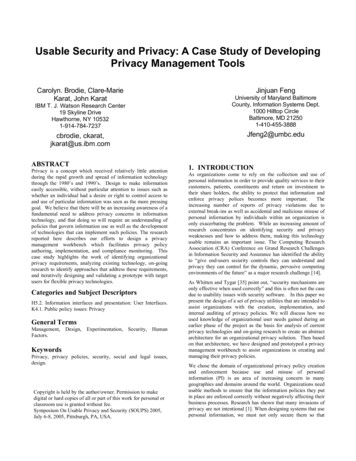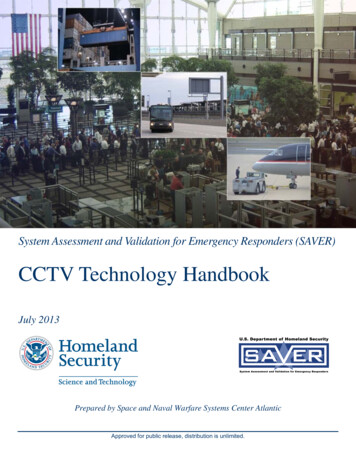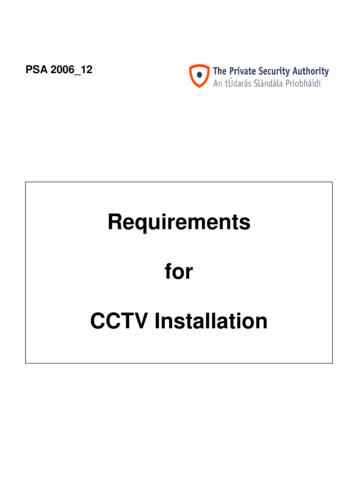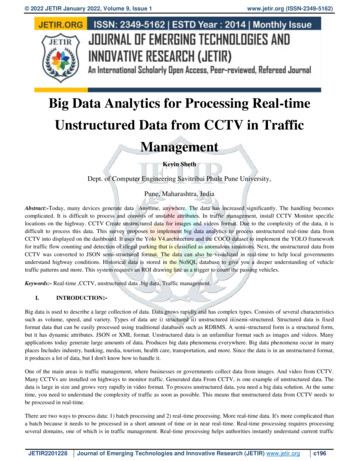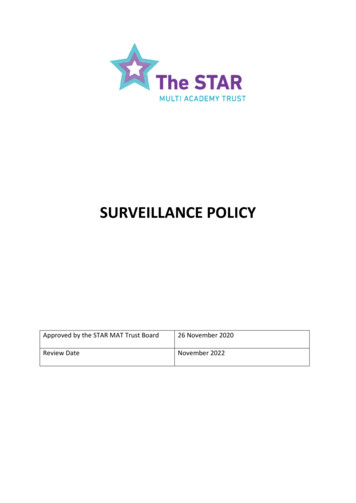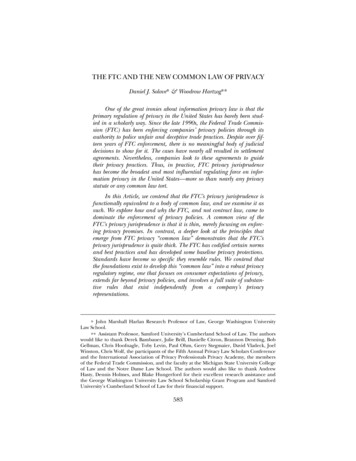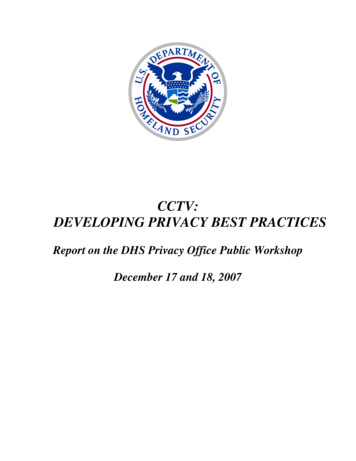
Transcription
CCTV:DEVELOPING PRIVACY BEST PRACTICESReport on the DHS Privacy Office Public WorkshopDecember 17 and 18, 2007
TABLE OF CONTENTS1. Executive Summary 12. Panel on Technology Perspectives .43. Panel on International Perspectives . 54. Panel on Community Perspectives . 65. Panel on Law Enforcement Perspectives 86. Panel on Legal and Policy Perspectives . 97. Panel on Developing Privacy Best Practices for the Use of CCTV .138. Workshop Conclusion 149. AppendixA. Workshop Agenda .16B. Best Practices for Government Use of CCTV .21C. Template: Privacy Impact Assessment for the Use of CCTV (DHS Programs).32D. Template: Privacy Impact Assessment for the Use of CCTV (State and LocalEntities) .45E. Template: Civil Liberties Impact Assessment .58CCTV: Developing Privacy Best PracticesReport on the DHS Privacy Office Workshopi
Executive SummaryIn December of 2007, the Department of Homeland Security (DHS) Privacy Office convened atwo-day public workshop to examine best practices for government use of camera technology,commonly referred to as closed circuit television (CCTV). Titled CCTV: Developing PrivacyBest Practices, the Workshop examined how technology, local and international communities,law enforcement, government agencies, and privacy advocates are shaping the use of CCTV andwhat safeguards should be in place as the use of CCTV expands.The Workshop served as a valuable resource to the Privacy Office in its joint effort with theDHS Office for Civil Rights and Civil Liberties to develop an informational guide to bestpractices for government use of CCTV. The best practices guide, along with sample templatesfor Privacy Impact Assessments (PIAs) customized for CCTV and the DHS template for CivilLiberties Impact Assessments, are included in the Appendix to this Workshop report. The DHSPrivacy Office and Office for Civil Rights and Civil Liberties hope that government agencieswill consider these resource materials in developing their CCTV programs and policies. Theseresources may be useful in helping government agencies build privacy and civil libertiesprotections into the design and implementation of a CCTV program. Failure to address privacyand civil liberties can undermine public support for the use of CCTV and erode confidence ingovernment’s ability to protect privacy and civil liberties while protecting the Homeland.Government agencies can avoid project delays and gather public support by ensuring that theappropriate safeguards and policies are in place before launching CCTV systems.The Workshop brought together leading academics, international government officials,researchers, law enforcement representatives, technologists, community leaders, and policyexperts. These panelists identified a range of challenges facing local governments, communities,and law enforcement regarding privacy and use of CCTV. The key topics discussed at theWorkshop included: CCTV technology and its impact on privacy;International perspectives on the use of CCTV;Law enforcement use of CCTV;Community perspectives on use of CCTV;Legal and policy considerations regarding the use of CCTV; andBest practices for the implementation and use of CCTV.The panel on Technology Perspectives opened the Workshop by providing a basic understandingof the current CCTV technologies in use. This discussion led into a more in-depth discussion onthe capabilities of the technology and video analytics being used today. The panel thendiscussed computer vision technology (privacy protections and visual surveillance); equipmentand architecture considerations (placement); and large system implementations and concludedwith a discussion on large system information management.The second panel addressed International Perspectives. Regulators and academics providedperspectives on lessons learned from abroad. The panel addressed implementing surveillanceCCTV: Developing Privacy Best PracticesReport on the DHS Privacy Office Workshop-1-
programs while taking into consideration the Fair Information Practices Principles (FIPPs) aswell as considering the general knowledge and understanding of the public. The academicpanelists highlighted the changing notion of public versus private space and the impacttechnology has on these definitions.The third panel focused on Law Enforcement Perspectives. This panel discussed the challengescommunity law enforcement organizations are experiencing as a result of the demand bycommunities for CCTV systems. The Law Enforcement representatives discussed such issues asthe reasons to have a CCTV system, the staff required to monitor the video screens, thepartnership between businesses and police departments, and the need to have in place policiesand procedures governing the operation of the cameras.The fourth panel, on Community Perspectives, profiled five U.S. cities in various stages ofimplementing CCTV systems. Representatives of Baltimore, Maryland; Chicago, Illinois;Hyattsville, Maryland; Stamford, Connecticut; and Norfolk, Virginia discussed how they wereproceeding to implement CCTV programs in their communities. The panelist from Hyattsvillehighlighted its policy-first approach before installing any cameras, which included anindependent assessment to review surveillance requirements for the city. The panelists discussedtheir challenges to date and their policies to address privacy and civil liberties concerns.The fifth panel, Legal and Policy Perspectives, provided an overview of constitutionalconsiderations and case law in the area of privacy, illegal searches, and the use of CCTV. Inaddition, the panelists discussed the lack of legal precedent regarding the use of CCTV andindividual rights and indicated that many cities are installing CCTV systems without clearpurpose or enforceable policies and procedures outlining protections for privacy, civil rights, andcivil liberties. The panel gave suggestions for what a community or agency should considerwhen developing policies and procedures and establishing best practices. The panel furtherdiscussed the effects CCTV systems have on every day activity and how the public, althoughsupportive of these systems, may alter everyday behaviors when they know they are beingcaptured on cameras.The sixth and final panel of the Workshop, Best Practices Perspectives, provided examples oncommunity policies and best practices based on the FIPPs. In addition, the panel providedsuggestions for how the DHS grant program could be enhanced to encourage CCTV applicantsto take into consideration public comments and community involvement prior to awardingmoney for surveillance programs. Appendix B, Best Practices for Government Use of CCTV,builds upon the recommendations of this panel, as well as the panel discussions throughout theWorkshop. The Workshop agenda and a full transcript of the Workshop are available on theDHS Privacy Office website at www.dhs.gov/privacy.Following the summary of the highlights of the Workshop, the Appendices provide a series ofresources to aid government agencies in drafting policies to protect privacy and civil libertieswhen implementing CCTV programs. Appendix A is the Workshop Agenda. Appendix B, BestPractices for Government Use of CCTV, provides a set of practices based upon the FIPPs thatbuild privacy considerations into CCTV decision making. Appendix C, Template for PrivacyImpact Assessment for the Use of CCTV by DHS Programs, is the PIA template the DHS PrivacyCCTV: Developing Privacy Best PracticesReport on the DHS Privacy Office Workshop-2-
Office will use to analyze the privacy considerations associated with DHS activities involvingCCTV. Appendix D, Template for Privacy Impact Assessment for the Use of CCTV by State andLocal Entities, is intended as a sample PIA for non-Federal agencies seeking to identify andaddress the privacy concerns posed by a CCTV program. Finally, Appendix E, Template forCivil Liberties Impact Assessments (CLIA), is the template the DHS Office for Civil Rights andCivil Liberties uses to evaluate DHS activities. Although the analysis in the CLIA focuses onFederal law, the civil liberties issues are consistent with those that a State and Local agency mayneed to address.As government agencies increasingly turn to technologies such as CCTV as a tool for lawenforcement and public safety, the need for policies to protect privacy and civil liberties growsstronger. The Workshop evidenced the need for such policies and revealed that manycommunities may not yet have them in place. The DHS Privacy Office and Office for CivilRights and Civil Liberties, therefore, hope that this report will help government agencies craftthese policies and demonstrate that privacy and civil liberties are valued and protected.CCTV: Developing Privacy Best PracticesReport on the DHS Privacy Office Workshop-3-
CCTV: Developing Privacy Best PracticesReport on the DHS Privacy Office Public WorkshopPanel on Technology PerspectivesThe panel on Technology Perspectives (Technology panel) opened the Workshop with anoverview of CCTV technologies, including how the technology works, what it does today andwill do in the future. The panel also discussed the problems and issues end users experience withthe rapid development of new technologies, not only in equipment but also storage andtransmission of data.In the development and design of any CCTV system, the Technology panel recommendedgetting the information technology (IT) team involved early to establish the partnership betweenphysical security and the IT infrastructure. The panel further recommended thinking through theday-to-day support plan, as if designing any other critical application. A camera programrequires more than just the initial purchase of the cameras; it requires long-term operationalplanning and support.The greatest issue that the Technology panel identified with regard to implementing a CCTVprogram was the application of video analytics – tools for analyzing motion, people, vehicles,and places. The panel described the rush to get more cameras as people find more value in thetechnology, but purchasing the cameras is the easy part, while using technology in an effectivemanner is much more challenging. The more cameras that are operating, the more video screensthat are needed, as well as more human monitors to view the screens. This then results in moredata that has to be analyzed, transported, stored, protected, etc. The panel stressed that quicklyimplementing video analytics requires more resources and may require more planning and timeto reach the intended goal. In some instances, programs may have to be pulled due to inadequateresources to handle the number of false positives/false negatives that may result. The key, asstated by the panel, is to make sure that the use of the video -- the value that is being attained -is equal to or greater than the cost of deploying the solution.In addition to discussing video analytics, panelists also discussed computer vision technologyand current research on quickly analyzing footage from large-scale video surveillance systems inorder to track suspicious people or view suspicious activities. Panelists discussed applyingprivacy protections (e.g., blurring images, encrypting data) for those persons who are not beingtracked or involved in a particular incident, and noted that technology exists to unmask orrecover high-resolution accurate images of faces if necessary.The panel further discussed key considerations when installing CCTV systems, including thetype of equipment based on the area under surveillance, the architectural requirements forplacing the cameras, and the infrastructure requirements, including existing and non-existing,lighting, power, and weather.The panel concluded its discussion by reviewing the challenges faced in implementing complex,large-scale CCTV systems and managing the large amount of data a large-scale CCTV systemgenerates. The panelists noted the need to consider such items as: building relationships withCCTV: Developing Privacy Best PracticesReport on the DHS Privacy Office Workshop-4-
those individuals or organizations that can influence the outcome of the project; managingcommunity commissions (e.g., planning); managing owners of critical national infrastructure;dealing with potential union issues; continuity of operations with surrounding municipalities;addressing underestimated cost-drivers; ensuring availability of proper power and back-uppower, if the system goes down; making key decisions such as LAN versus standalone systems;implementing overt versus covert systems to deal with deterring crime versus capturing acts ofterrorism; and finally, addressing engineering, configuration control, and life-cycle management.In managing the large amount of data a large-scale CCTV system generates, the technologypanel stressed the need to address: the challenge of information overload; informationmanagement and retrieval; what is done with the information after it is collected; and thepersonnel and expertise needed to actually use the system effectively.Panel on International PerspectivesDuring the International Perspectives panel, privacy regulators from Canada and the UnitedKingdom discussed how their countries took the FIPPs into consideration either before or afterimplementing CCTV programs in their countries. The international privacy regulatorsreferenced their guidelines or codes of practice on surveillance, which specify: Purpose specification (e.g., what is the surveillance scheme trying to do? Is CCTV thebest alternative?); Accountability/oversight (e.g., who is legally responsible for the CCTV system? Privatesector? Local government?); Use limitation (e.g., cameras not intruding on private space when monitoring a towncenter, appropriate use of stored images, blurring faces); Transparency (e.g., providing notice and contact information to the general public); Data quality (e.g., image quality, hardware maintenance, etc.); Use limitation/retention (e.g., restricting access, specifying timeframe for retention and inwhat mode); Security (e.g., clear and well-documented handling procedures, training, guidelines foronward transfers, audit procedures; building privacy and security safeguards into theprograms from the outset); and Access/redress (e.g., staff awareness of the rights of individuals to have access to theirimages, exceptions, and a redress procedure).The regulators evaluated the general population (through privacy impact assessments andconsultations) and found that where individuals understand the benefit of CCTV technology,they are more trusting in its use. When they gauged how citizens felt about surveillance(including CCTV), however, they found that it was critically important to invest time garneringthe public’s trust when deciding to utilize this technology. Having a “consultative, collaborative,cooperative approach” was particularly important when implementing video surveillancecameras, and encouraging the private sector and concerned individuals to consult with regulatorshelped the regulators implement video surveillance within the law while still meeting thegovernment’s surveillance needs. Government agencies often found that technical surveillancewas not the best use of resources; rather, additional police forces, better lighting, and the likewere more effective.CCTV: Developing Privacy Best PracticesReport on the DHS Privacy Office Workshop-5-
The academics on the International panel discussed the rapid change in what is considered a“public” versus “private” space. They also defined surveillance to include audio, visual, andolfactory capturing devices, as well as other more technical systems, such as radio frequencyidentification devices (RFID). They described surveillance as a “complex cluster of technologiesthat are morphing all the time into different kinds of relations” and as such, privacy policies needto fluidly adapt to such emerging technologies. Trying to pinpoint the reasons for using CCTValso posed a problem, as they reported that most evaluations of CCTV have returned very mixedmessages regarding its use and usefulness. In fact, most research found that CCTV did not stopcrime, but was useful for obtaining evidence after the fact. Yet, many jurisdictions abroadcontinue to spend large amounts of money procuring such technology.One of the academic panelists emphasized two important points addressing the FIPPs ofoversight and transparency. He called out the data protection authority’s ability to ensurecompliance with the written CCTV guidelines; although with the privacy regulators limitedresources, such oversight is almost impossible given the number of systems. Additionally,despite the requirement under the guidelines to provide notice to individuals that CCTV is inplace, the public does not have a meaningful opportunity to withhold consent to having an imagecaptured, used, or stored.After the Workshop, the United Kingdom’s Information Commissioner’s Office issued anupdated “CCTV Code of Practice,” 1 which takes into account technology, advances in the use ofCCTV, and the wider legal environment in which it operates. The Office of the PrivacyCommissioner of Canada and the Ontario Information and Privacy Commissioner have alsoissued a number of publications dealing with video surveillance. 2Panel on Community PerspectivesFive communities took part in the Community Perspectives panel discussion. The cities includedStamford, Connecticut; Baltimore, Maryland; Norfolk, Virginia; Chicago, Illinois; andHyattsville, Maryland. Each city representative discussed their community’s approach toimplementing CCTV technology. Two cities have very elaborate programs in place (Chicagoand Baltimore), while others were in the process of designing their program (Stamford andHyattsville). Each city discussed lessons learned and noted some of their successes andrecommendations for other cities to consider when implementing CCTV programs.The board representative from the city of Stamford, Connecticut began the Community panel bynoting lessons learned from Stamford’s CCTV implementation experience. First, he advised1Information Commissioner’s Office, CCTV Code of Practice, revised addition, (2008), available ata protection/detailed specialist guides/ico cctvfinal2301.pdf2Office of the Privacy Comm’r of Canada, OPC Guidelines for the Use of Video Surveillance of PublicPlaces by Police and Law Enforcement Authorities (Mar. 2006), available athttp://www.privcom.gc.ca/inforamtion/guide/vs 060301 e.asp. See also Info. & Privacy Comm’r ofOntario (Canada), Guidelines for Using Video Surveillance Cameras in Public Places (Sept. 2007),available at CCTV: Developing Privacy Best PracticesReport on the DHS Privacy Office Workshop-6-
communities to have policies and procedures in place before launching a program. Second, herecommended having a collection of “horror stories” about CCTV abuses to share with councilmembers in order to stress that abuses can and do occur and need to be accounted for in theCCTV policies. Finally, he recommended including specific language in local ordinancesreferencing what abuses can occur in the absence of clear policies and procedures, so wherecouncil members are unable to understand the specific technical language of the ordinance, theycan still understand what abuses the ordinance is intending to prevent.The council member from Norfolk, Virginia discussed Norfolk’s approach to implementingCCTV technology by addressing key first steps such as having policies in place, conducting sitevisits to other cities, and obtaining public support. The council member noted the importance ofintegrated resources (e.g., courts, transportation, and government entities) and the need to notoversell the abilities of the cameras. Further he stressed the importance of having protections inplace to guard against abuses to the extent possible since abuses will happen. Finally, thecouncil member provided insights into making Norfolk’s CCTV program more effective byusing cameras in conjunction with other safety measures, such as more lighting, better publicaccess, and promoting community action.Two representatives participated from the city of Baltimore, Maryland, one from the mayor’soffice and the other from the private-public partnership that funded the city’s downtown cameraprogram. The representatives discussed the implementation of the city’s CCTV system and itseffectiveness in deterring crime. Baltimore hired a law firm to help develop protocols that hadeven more privacy protections than what the law required. The Baltimore representatives alsonoted the transparency of Baltimore’s program, including signs on every block notifying of theuse of video surveillance and allowing the community to come in and view the monitoring sites.The Baltimore representatives further noted the checks and balances that are in place to deterabuse, including only using cameras that see what the naked eye can see, having two or morewell-trained monitors on duty at all times, and having video feeds that can be viewed innumerous locations, so people can see what the monitors are looking at. The panelists notedthat, after the first month, there was a 50 percent decrease in crime from the previous year, andthat crime dropped in every area where cameras were placed. From 2000 to 2006, the crime inthe downtown area declined 47.75 percent and is now considered the safest place in Baltimore.Chicago is another city with a mature CCTV system. The Chicago panelist noted a number ofitems that make Chicago’s system effective, including the use of multiple and legacy systems;the varied sources of funding for each system (e.g., state, federal, city and forfeiture money); thepolicies and procedures the city has in place (including data retention schedules); and the city’sadherence to a consent decree, which addresses issues like audits, training, and data storage, andensures everyone understands the requirements for operation of a surveillance system. He noteda number of key challenges, including understanding the power of developing technologies andthe integration of different technologies, such as gunshot detection technology with video,olfactory technology with video, and targeted video along with bomb detection technology. Healso identified a number of other challenges: funding system maintenance; Freedom ofInformation Act (FOIA) requirements; concerns regarding requests for certain data and thepotential for abuse (e.g., people using data about others to violate privacy or to perpetrateCCTV: Developing Privacy Best PracticesReport on the DHS Privacy Office Workshop-7-
identity theft); and managing and preserving data so as to not violate evidentiary requirements ordestroy exculpatory evidence.Taking a different approach, the city of Hyattsville, Maryland contracted an IT consulting firm tohelp develop a roadmap for implementing its CCTV program, which would focus on commercialand development areas based on crime statistics. The panelist from Hyattsville highlighted itsrecently completed, independent assessment to review surveillance requirements for the city.The assessment included site surveys at locations of interest, deployment and operationsrecommendations, and an outline of steps to meet the city’s surveillance goals. The city heldpublic meetings to make sure the community had ample opportunity to weigh in on its program.Following the introduction of the program, a final report was made available to the community.The report addressed system design, technology, effect on the community, awareness, viewsfrom all the proposed camera locations, and feedback or concerns on camera views. The citypartnered with local businesses and developers for funding assistance and infrastructure and hasseen a great deal of success as a result of its planning.A key part of the assessment was the recommendation that the system must allow foraccountability of the data being captured and how it is handled. The assessment stated that thesurveillance system must have the ability to demonstrate that the use of the system has beenlimited to its intended justice and public safety purposes. It provided that this could beaccomplished by including accountability features that allow for the city to report on the usage ofthe system – access, data capture and retention policies. The assessment noted that suchaccountability is paramount in maintaining public confidence that the information being gatheredis properly protected and utilized in a manner that demonstrates respect for individual rights andprivacy.Hyattsville has adopted a policy-first approach before installing any cameras. The city is usingpolicy recommendations from the Urban Institute and is contacting other municipalities whohave proceeded with CCTV implementation to obtain their policies for review. Communityinvolvement and transparency considerations include a joint monitoring program and communityaccess to observe what is being monitored, how it is being monitored, and how it works. Thecommunity is also involved in the development of training requirements and policies.Hyattsville’s goal is to be a model city for the implementation of a CCTV system.Panel on Law Enforcement PerspectivesThe panel on Law Enforcement outlined three reasons to implement CCTV technology:deterrence; response; and investigation. The Law Enforcement panelists commented favorablyon the use of CTTV for evidence after a crime has been committed and gave many examples ofhow it has served as a key tool in solving crime. All panelists agreed it is typically mostbeneficial for “after the fact” cases, where you can go back and search the video camera forclues. One law enforcement official stated that their camera system is “event driven,” meaningno one actually watches the footage 24/7, but they use it when incidents arise and the cameraspotentially hold information that may help to solve a crime.CCTV: Developing Privacy Best PracticesReport on the DHS Privacy Office Workshop-8-
Law Enforcement panelists further noted that CCTV can benefit the safety of officers respondingto calls as well as spot crimes taking place. If the cameras are monitored while a crime is takingplace, law enforcement would be able to dispatch an officer to the scene. In situations whereofficer safety is an issue, a dispatcher or monitor would be able to observe the scene even beforean officer is sent.CCTV can also assist with the allocation of key resources. For example, cameras can be set upin safer areas of a community allowing municipalities the opportunity to allocate additionalpolice officers to more troubled areas of a city. In addition, cameras in high surveillancedetection areas can be used to avoid unnecessary police investigations and responses (e.g.,determine that an activity is legal and no police response is necessary.)Law Enforcement representatives stated that if given the option to choose between more policeofficers or CCTV, they would always choose the officers. Nevertheless, most communities arewelcoming and inquiring about CCTV placement. All of the panelists agreed, however, that it isabsolutely critical for communities to think carefully through their needs, understand what thecameras can and cannot do, have a thorough review and assessment, and then develop policies toaddress how the cameras will be used and privacy protected before rolling out a CCTV program.Many businesses have requested that law enforcement install cameras in “business districts,”often times offering to pay for the cost of the equipment. Private businesses have increasedinterest in CCTV for crime prevention and to assist in solving crimes after the fact. This bringsup a number of challenges for local law enforcement. For example, will police monitor theseprivately-owned cameras? If so, who will pay for the police to do so? Will the police have realtime access to these cameras? Will poorer neighborhoods that do not have businesses tosubsidize the cost of cameras in their area be neglected?Law Enforcement panelists made the case for having relationships with local businesses to saveon the cost of cameras and to cover more public space than with law enforcement controlledcameras (e.g., parking lots and streets).As the conclusion of the panel, researchers from the Urban Institute previewed their outline for anew two-year study into the effectiveness of CCTV in four selected communities. The study,funded by the Department of Justice, hopes to provide important findings to help guidepolicymakers’ future decisions regarding CCTV deployment. The Institute study will examinehow camera systems are implemented and used, as well as look at ways that cameras may haveboth positive and negative impacts, including exploring some of the unintended consequences ofCCTV use. The research will look at community needs, camera types, implementation decisionssuch as camera location, and will also seek to evaluate the costs and benefits of these systems inthese four communities.Panel on Legal and Policy PerspectivesThe panel on Legal and Policy Perspectives provided the context for the many issues andconcerns raised by the previous four panels. The Legal and Policy panelists agreed that it wouldbe difficult to argue against the use of CCTV on the basis of current case law, but the growingCCTV: Developing Privacy Best PracticesReport on the DHS Privacy Office Workshop-9-
pervasiveness of the technology could lead to more stringent requirements and a call for greaterFourth Amendment protections in the future. The challenge with developing laws andregulations for
Best Practices, the Workshop examined how technology, local and international communities, law enforcement, government agencies, and privacy advocates are shaping the use of CCTV and . transmission of data. In the development and design of any CCTV system, the Technology panel recommended getting the information technology (IT) team involved .
